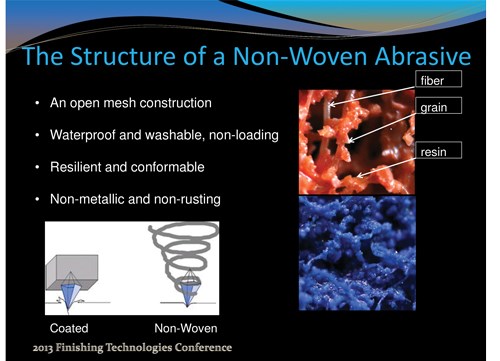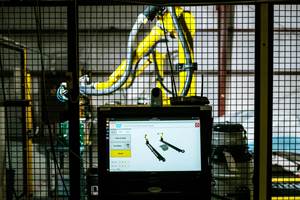Advancements in Non-Woven Abrasives
Abrasive technology is streamlined for metal fabrication applications.
Most economists say the United States industrial outlook for 2014 will show modest growth throughout the year.
While this is good news, industrial manufacturers across various industries—from aerospace and transportation to energy, maintenance/repair operations and metal fabrication job shops—must look for ways to increase productivity while maximizing overall efficiency to keep operating costs down.
The question is: How can industrial manufacturers meet higher demand without increasing overhead?
Metal fabrication processes such as surface preparation and finishing are good places to start. The processes include light stock removal, blending, deburring, preparation, cleaning and finishing. These applications can be very labor-intensive and may represent a disproportionate share of the total job cost for metal fabricators.
As the demands for improved finishes increase—and companies like Ford announce that the F-150 truck is moving to aluminum as the primary material—fabricators need abrasives solutions that streamline their operations. Non-woven abrasives can provide an excellent solution.
What Is Non-Woven?
In its simplest form, non-woven it is an abrasive product where the base is an open nylon filament web to which abrasive grain is bonded.
The advantages of non-woven abrasives are many. It is resilient, comfortable, waterproof, non-loading and non-rusting. This allows for the following advantages when used on portable grinding, sanding and finishing operations:
-A controlled cut with minimal stock removal
-A predictably consistent, uniform finish
-Ease of use and reduced operator training
-Increased safety over other grinding methods
-Ability to be used on irregular surfaces.
Next-Generation
Non-wovens have been around for more than 50 years and have been used primarily for cleaning and finishing. Recent advancements in all of the product components have not only improved the core applications but also extended the performance into other metal fabrication applications.

Non-woven backing: An expansion in the porosity of the fibers from very open to very tight has provided products that work across more applications and materials. Non-wovens now offer strong performance in light metal removal, deburring, blending and finishing, and they excel on material where loading is an issue.
Bond chemistry: Previously, when the resin overheated, it would often smear the work surface. New bond chemistry has virtually eliminated this.
Grain technology: Once the domain of fine grit, low-cost aluminum oxide and silicon carbide abrasives, the new resins and nylon mesh now allow for integration of both coarser grits and premium abrasives. Extra-coarse (36-40) and coarse (50-80) are now used for stripping and light metal removal.
High-performance grains such as ceramic alumina with its ultra-sharp, micro crystal structure, and agglomerated grains that allow coarse grits to be built out of finer particles, are revolutionizing the cut rate and life of all non-woven products.
Primary Advantages
The next generation of non-woven provides benefits of faster cut rate, longer life and decreased rework due to smearing. Also, these products are extremely versatile. In many cases, multiple operations can be done using one non-woven disc.
The innovative disc material is stiff enough for challenging applications, but also soft enough to prevent gouging that can necessitate rework. An open-mesh-structured product does not load on coatings, adhesives or softer metals. And when used to deburr, the discs will not snag or shed like cloth or fiber discs. This advanced technology allows for improved cycle times, abrasive life and overall cost-per-part savings compared with traditional aluminum oxide grinding products.

Here’s an overview of non-woven use in industry:
Aerospace: For aerospace manufacturing, advanced surface conditioning products can be extremely useful for blending and deburring applications involving airframes and investment cast parts. By simplifying the process, aerospace manufacturers are now able to reduce cycle times, enhancing productivity and efficiency.
Transportation: These new technologies are also ideal for automotive, trucking and bus applications, such as frame repairs, weld blending, and surface paint preparations, including scuffing and blending. By providing fast, smear-free performance, transportation industry manufacturers can improve productivity through reduced labor requirements for surface finishing operations.
Energy: Quick and effective surface conditioning can help energy generation operations meet tight deadlines and decrease downtime. For example, new non-woven technology can be used in oil and gas operations to deburr pipe threads for rapid and precise pipeline fittings. Wind power operations can refurbish turbines and repair cracks in turbine blades.
Metal Fabrication: Maintenance and repair operations and metal fabricators can use recent innovations in non-woven surface conditioning for various applications, including blending, deburring and weld blending, surface prep prior to painting, rust and paint removal, and surface preparation prior to blending.
Increased Productivity
Recent advances in non-woven technology have made this a great area to increase productivity while keeping costs down. Innovative design and materials science have combined to yield a new generation of high-performance surface conditioning products that are durable, flexible and easy to use.
As the economic landscape begins to show signs of improving, manufacturers will be well-served to use new non-woven technology to help them efficiently meet increased demands while streamlining operations to remain competitive in unstable economic times.
Paul Krupa is senior product manager for Norton/Saint-Gobain Abrasives. For more information, please visit nortonbeartex.com. Photos and charts courtesy of Norton/Saint-Gobain Abrasives.
Norton
Related Content
AI-Powered Robotic Solutions Support High-Mix Finishing
AI startup offers automation innovations for high-mix, high-variability, manual surface finishing applications.
Read MoreBlast Nozzle Features Enhanced Noise Reduction
Kennametal adds noise-reducing Blast Ninja to portfolio of abrasive blast nozzles.
Read MoreUnderstanding Shot Peening
A look inside shot peening — a process of “hammering” of work pieces with precisely defined blast media.
Read MoreModernizing Wastewater Treatment and Recovery
Source: Kontek Kontek’s “spigot to drain” Source Water and Wastewater Solutions offer integrated technologies to modernize your water & wastewater treatment and recovery.
Read MoreRead Next
A ‘Clean’ Agenda Offers Unique Presentations in Chicago
The 2024 Parts Cleaning Conference, co-located with the International Manufacturing Technology Show, includes presentations by several speakers who are new to the conference and topics that have not been covered in past editions of this event.
Read MoreDelivering Increased Benefits to Greenhouse Films
Baystar's Borstar technology is helping customers deliver better, more reliable production methods to greenhouse agriculture.
Read MoreEpisode 45: An Interview with Chandler Mancuso, MacDermid Envio Solutions
Chandler Mancuso, technical director with MacDermid Envio discusses updating your wastewater treatment system and implementing materials recycling solutions to increase efficiencies, control costs and reduce environmental impact.
Read More























